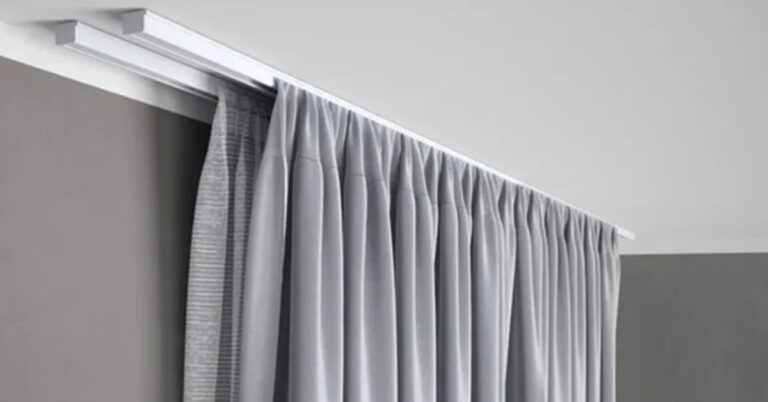Stuck between ceiling tracks and wall-mounted curtain rods? You’re not alone.
This choice stumps so many homeowners, and picking wrong can throw off your whole room vibe.
The right option can make your windows look stunning while the wrong one… well, let’s just say it might leave your space feeling a bit off.
I’ve seen beautiful rooms ruined by badly mounted curtains and simple spaces transformed by getting this detail right.
The good news? You don’t need a design degree to figure this out.
Just some straight talk about what works where and why.
Ready to find out which option makes more sense for protecting your home? Let’s jump right in.
10 Tips: What Is Better Metal Ceiling Curtain Tracks Or Wall-Mounted Options
So we’re looking at 10 super practical tips to help you decide between metal ceiling tracks and wall-mounted curtain rods.
These aren’t just random thoughts—they’re based on what actually works in real homes.
I’ve pulled together everything you need to know to make this decision without getting overwhelmed.
Each tip tackles a different angle, from looks to installation to cost. By the end, you’ll know exactly which option fits your space best.
Understand the Differences Between Ceiling Tracks and Wall-Mounted Rods
First things first—let’s get clear on what makes these two options different.
Ceiling tracks attach directly to your ceiling and hang straight down.
The track itself usually hides behind a valance or sits nearly invisible against your ceiling.
The curtains hang down in a straight line, creating this really clean look.
Wall-mounted rods, on the other hand, stick out from the wall above your window.
They come in all sorts of finishes and styles—from simple metal rods to fancy decorative ones with cool finials at the ends.
The rod itself becomes part of your room’s look.
Here’s what most people miss: ceiling tracks take up zero wall space, while wall-mounted rods need that bit of wall above your window.
If you have weird walls or windows that go all the way up, ceiling tracks might be your only option.
The way curtains move is different too.
On ceiling tracks, they glide super smoothly in a straight line.
With wall-mounted rods, they sort of sweep around the curved ends if you get that style, which can look really nice but takes up more space when open.
Consider Your Room Layout and Ceiling Height
Your room’s shape and size will push you toward one option or the other.
Got super high ceilings? Wall-mounted rods might make more sense—who wants to climb up 12 feet to install ceiling tracks? But if your ceilings are standard height (around 8 feet), either option works fine.
Corner windows are tricky! Wall-mounted rods get awkward at corners, but ceiling tracks can go around corners smoothly.
I’ve seen ceiling tracks work magic in bay windows too, following the exact shape without any weird gaps.
Floor-to-ceiling windows basically demand ceiling tracks.
There’s just no wall space to mount a rod.
The shape of your room matters too.
Open concept spaces often look better with ceiling tracks because they create these nice,
clean lines. Traditional rooms with clearly defined spaces tend to work well with wall-mounted rods that match other elements in the room.
Think about where your furniture goes.
If you need to put something tall near the window, ceiling tracks won’t get in the way like wall-mounted rods might.
Evaluate the Weight and Type of Curtains You Plan to Hang
Heavy velvet drapes and flimsy sheers need totally different support systems.
This is super important and people mess it up all the time.
Ceiling tracks generally hold more weight when installed properly.
The weight distributes evenly across the entire track.
This makes them perfect for heavy blackout curtains or thermal drapes.
For example, choosing the right curtain track from Direct Fabrics or from another reputable brand from the UK can be a good starting point when you’re planning to hang heavier curtains.
Wall-mounted rods come in different thicknesses.
Skinny ones (less than 1 inch diameter) work fine for lightweight curtains but will sag with heavy ones.
Nothing looks worse than a droopy curtain rod! For heavy curtains, you need rods at least 1.5 inches thick with support brackets every 4-5 feet.
The curtain style matters too.
Grommet-top or tab-top curtains usually work better on rods.
Pinch-pleat or ripple-fold styles need special carriers that come with track systems.
If you love to switch curtains seasonally—light in summer, heavy in winter—make sure whatever system you choose can handle both. I’d go with something that handles the heaviest option you might use.
Check Your Wall and Ceiling Strength Before Choosing
This tip might save you from a falling curtain disaster! Not all walls and ceilings are created equal.
Drywall ceilings need special anchors for ceiling tracks.
If you have old plaster ceilings, you really need to find the ceiling joists for mounting. I’ve seen people skip this step and end up with tracks that pull right out of the ceiling—along with chunks of plaster!
Wall-mounted rods need solid anchoring too, but they’re a bit more forgiving.
You can use drywall anchors for lighter curtains, but for heavy ones, try to hit wall studs with at least some of your brackets.
Concrete or brick walls and ceilings need special drill bits and anchors.
It’s doable but takes more work.
Got popcorn ceilings? They’re a pain with ceiling tracks.
You’ll need to scrape the texture away where the track mounts or use a mounting board that attaches to the joists first.
If your walls or ceiling aren’t strong enough for your first choice, don’t force it! Better to switch to the other option than have everything come crashing down later.
Think About the Aesthetic You Want to Achieve
Your curtain hardware makes a bigger style statement than most people realize.
Ceiling tracks disappear from view, putting all focus on the curtains themselves.
This works beautifully in modern, minimalist, or contemporary rooms.
The curtains look like they’re floating, which creates this really sleek look.
Wall-mounted rods become part of your decor.
They can be simple and understated or ornate statement pieces.
The finials (those decorative ends) come in so many styles—crystal balls, twisted metal, wooden carvings—they’re like jewelry for your windows.
Traditional or vintage-inspired rooms usually look better with visible curtain rods.
Mid-century modern spaces can go either way.
Super contemporary spaces almost always look better with ceiling tracks.
Consider how the hardware matches other elements in your room.
If you have black door handles and light fixtures, a black curtain rod ties everything together nicely.
Ceiling tracks don’t offer this kind of coordination opportunity since they’re hidden.
Don’t forget about color! Wall rods come in every finish imaginable, while ceiling tracks usually come in white, silver, or black.
That limited color choice pushes some people toward wall rods right away.
Look at the Flexibility and Customization Each Option Offers
How likely are you to change your mind or rearrange your space? This affects which option makes more sense.
Ceiling tracks win for flexibility.
They work with almost any curtain style, and you can add or remove curtain panels easily.
Many track systems let you add room divider curtains or create curved layouts.
Some even have motorized options.
Wall rods offer tons of style options but less functional flexibility.
Changing the rod means new holes in your wall. And you can’t easily create curves or corners with standard rods.
Custom windows love ceiling tracks.
Bay windows, arched windows, corner windows—tracks can follow any shape. Wall rods struggle with unusual shapes.
Consider rental situations too.
Some ceiling tracks can mount with tension, leaving no holes. That’s great for apartments where you can’t damage walls.
If you rearrange furniture often, ceiling tracks keep curtains out of the way, making it easier to move things around below them.
Compare Installation Difficulty and Requirements
Let’s be real about the work involved with each option.
Ceiling tracks need more precise installation.
They must be perfectly level or your curtains will drift to one side.
You’ll need a buddy to help hold things while mounting, and it’s all overhead work, which gets tiring fast.
Wall-mounted rods tend to be easier for DIY projects.
You can see what you’re doing better, and minor mistakes in placement aren’t as noticeable.
They typically need fewer mounting points too.
For ceiling tracks, you’ll need a good drill, level, stud finder, ladder, and possibly special drill bits depending on your ceiling material.
Wall rods need similar tools but are generally more forgiving.
Installation time differs too. Wall rods usually take 30-60 minutes per window. Ceiling tracks often take twice that, especially for first-timers.
If you’re not handy, professional installation costs more for ceiling tracks than wall rods in most cases. Something to factor into your budget!
Assess Long-Term Durability and Maintenance Needs
Which option will still look good and work well years from now?
Quality metal ceiling tracks last practically forever.
The carriers that hold the curtains might need replacing eventually, but the track itself rarely fails.
The downside? Dust collects in the track and it’s hard to clean since it’s way up high.
Wall-mounted rods need tightening occasionally as curtains get pulled back and forth.
The brackets can loosen over time. But they’re super easy to clean—just run a dust cloth over them.
Ceiling tracks hide from sun damage and curious kids or pets, which is a plus.
Wall rods are more exposed to both. I’ve seen toddlers hanging from curtain rods (not recommended!), which puts stress on the mounts.
For really long-term thinking, ceiling tracks are harder to remove completely when you want a change.
They often leave more noticeable holes that need patching. Wall rod holes are typically smaller and easier to fix.
Factor in Cost Differences Between Metal Ceiling Tracks and Wall Mounts
Your budget might make this decision for you.
Basic wall-mounted rods start much cheaper than ceiling tracks.
You can find decent ones for small windows starting around $20-30. Basic ceiling tracks usually start at $40-50 for the same width.
But—and this is important—the price gap shrinks with quality and size.
A really good, substantial wall rod with nice finials for a large window replacement might cost just as much as a ceiling track.
Installation costs change things too.
If you’re hiring help, ceiling tracks usually cost more to install professionally.
Don’t forget the hidden costs.
Ceiling tracks often need special curtain hooks or tape.
Wall rods might need specific curtain styles like grommets or rod pockets.
The cheapest option now might cost you more later.
Super cheap wall rods bend and sag under heavy curtains, forcing you to replace them.
Better to spend a little more upfront on whichever system you choose.
Choose the Option That Best Enhances Functionality and Space Use
The final decision comes down to how you actually live in and use your space.
Ceiling tracks work better when you open and close curtains frequently.
They glide more smoothly and don’t stick like some wall-mounted rods do. If you adjust your curtains multiple times daily, this matters a lot.
Wall-mounted rods create a bit more space between the window and curtain, which helps with airflow.
This can be important if you open windows often or have radiators underneath.
Think about cleaning too. Ceiling-mounted curtains hang straight down, making it easier to clean the floor underneath.
Wall-mounted curtains create that little pocket of space that collects dust and makes vacuuming trickier.
Privacy needs matter. Ceiling tracks let curtains close more completely with fewer gaps at the edges.
Wall-mounted curtains sometimes leave small light gaps at the sides.
Consider future changes too.
If you might want to add blinds or shades later, wall-mounted rods leave more space for adding these extras. Ceiling tracks limit your options a bit more.
Conclusion
So which is better—ceiling tracks or wall-mounted rods? The answer depends totally on your specific space and what you need from your window treatments.
Ceiling tracks shine in modern spaces, rooms with unusual windows, or when you want that super clean look with the hardware hidden away.
They handle heavy curtains like champs and work around corners and curves that would stump a regular rod.
Wall-mounted rods win for easier installation, lower starting costs, and when you want the hardware to be part of your decor style.
They’re also easier to maintain and clean over time.
Listen to what your space is telling you.
Sometimes your room layout or window style practically makes the choice for you.
Other times, it comes down to the look you love and how you use the space day to day.
Whatever you pick, don’t cheap out completely.
Quality matters with curtain hardware—it’s one of those things where spending a little more pays off every single day when your curtains open and close smoothly instead of getting stuck or sagging.
Your windows deserve some love! They’re huge focal points in any room, and getting the curtain hardware right makes all the difference between “something looks off” and “wow, this room feels finished and pulled together.”



